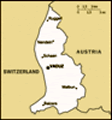Advertisement
In my years of wandering the planet, I have had the opportunity to visit kingdoms, constitutional and otherwise, as well as the odd emirate and sultanate. But I had never been to a principality until I set foot in teeny-tiny Liechtenstein a couple days ago.
When I was in elementary school, I stumbled on a book about the micro-states of Europe – Andorra, San Marino, Monaco, the Vatican City, and, of course, Liechtenstein (Luxembourg, although on the small side, is a giant in comparison to these guys, so was not included) – and I was entranced, sparking an early interest in such compact political entities. How can such a country exist in this day and age? How can it sustain itself as a distinct unit in this globalizing world?
My travels have taken me to some other pretty small places, including one of my favorite spots on earth, the Faroe Islands (see some of my first entries in this travelblog!). These islands boast a population of a whopping 48,000, and are largely self-governing (although officially still part of the domain of the Kingdom of Denmark). But Liechtenstein is the smallest fully sovereign state in which I’ve ever traveled.
Occupying a stretch of the upper Rhine Valley, it is only about 25km from north to south and a mere 6km wide at its widest. Its total area is about 160 sq km – slightly less than the District of Columbia! There are also only about 35,000 people, about the amount of a small city (Auburn, Indiana, my hometown boasts just shy of half that amount).
Despite its pint-sized proportions, doubly-landlocked* Liechtenstein packs a physical wallop. The flat plain that stretches along the Rhine River (which happens to define the country’s border with Switzerland) rises dramatically to a looming shield of craggy mountain (the spine of which defines the border with its other neighbor, Austria). You go from about 430m above sea level to almost 2,600m in the span of few kilometers. Vaduz, the capital (with only 5000 people!), nestles at the base of these mountains and is overlooked by a fairytale castle perched on a stony cliff – a castle that still serves as the private residence of Reigning Prince Hans-Adam II and his son, Hereditary Prince Alois. Completing the fairytale element.
(Apparently, however, the princes of Liechtenstein haven’t always lived in Liechtenstein itself. From 1719, when
it formally became a principality within the Holy Roman Empire, until the mid-20th century – several decades AFTER the country gained full independence - they ruled from their palace in Vienna. Prince Hans-Adams II is actually the first to be born in Liechtenstein!)
Like the country as a whole, Vaduz’s size belies its rich offerings. This is clearly a prosperous place. Outside a few schmaltzy tourist shops catering to the tourist groups that make a quick stop just to say “hey, we were in Liechtenstein”**, high end retails stores are rife throughout town. There are also innumerable business and bank offices, due to the country’s reputation as a tax haven***. Culturally, there are several great museums, including the tidy little national museum (though all its explanations were in German) and the surprisingly world-class Kunstmuseum Liechtenstein, a striking black-cube of a building devoted to modern art (including the private collection of the prince).
After lunching on local veal bratwurst smothered in fried-onion sauce, washed down with a local beer (gotta love the Germanic world), I decided to venture out of the “bustle” of cosmopolitan Vaduz and get as close to the princely castle as I could (although no visits
are allowed, as was made abundantly clear by a number of signs). The steep road leading out of town gave way to steep trail of switchback turns through the forest. In fifteen minutes or so, I was standing just below the medieval walls, with sunny views across the Rhine Valley. I noticed a sign for a trail heading into the forest, part of the Alpine Way, and decided to take advantage of the momentarily good weather (it was rather moody the entire day, switching from grey clouds spitting rain to bright sun and blue sky and back) for a short hike in the quiet mountainside. This taste of the Liechtenstein countryside made me ache to undertake some more trekking – perhaps covering the length AND breadth of the country. It is truly a gorgeous little principality.
As my day in the anachronism that is Liechtenstein came to a close, I decided it was time to get a start on the grand tour of the micro-states of Europe that I had planned so many years ago. Liechtenstein proved to be a great starting point. So next stop: Monaco!
*Meaning it is surrounded by other landlocked countries. The only
other state with this characteristic is Uzbekistan!
**I was surprised by how concentrated the tourists seemed to be. There was even a busload of elderly Chinese – who, for lunch, tottered over to the town's Chinese restaurant! Once I left the short stretch of the pedestrianized Stadtle, I saw few other tourists. Indeed, there was almost no one, tourist of Liechtensteiner, on the trails radiating throughout the hills above town.
***Actually, for a while Liechtenstein had a reputation as a money laundering center for this very reason. But in recent years , the government has been cracking down on illicit financial transactions in an attempt to improve its sullied reputation. (Still, I was intrigued by the number of “private banks”…)
Advertisement
Tot: 0.056s; Tpl: 0.012s; cc: 12; qc: 28; dbt: 0.0299s; 1; m:domysql w:travelblog (10.17.0.13); sld: 1;
; mem: 1.1mb























